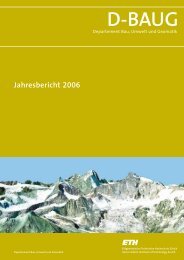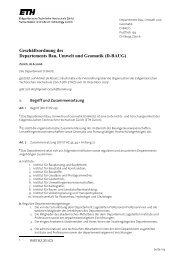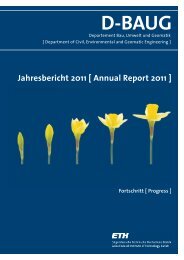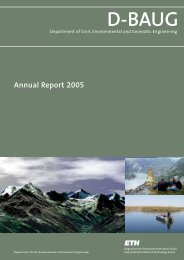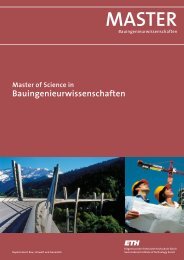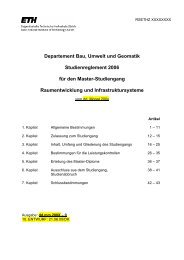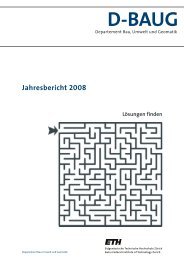D-BAUG - Departement Bau, Umwelt und Geomatik - ETH Zürich
D-BAUG - Departement Bau, Umwelt und Geomatik - ETH Zürich
D-BAUG - Departement Bau, Umwelt und Geomatik - ETH Zürich
Create successful ePaper yourself
Turn your PDF publications into a flip-book with our unique Google optimized e-Paper software.
Field Trip<br />
In particular, measures taken and developed, especially<br />
the implementation of protective measures, were brought<br />
home to our students.This included setting up sanctuaries<br />
in spring water catchment areas and constructing an elaborate<br />
monitoring system which, by means of specially<br />
developed sensors, measures the water quality parameters<br />
constantly online in very short intervals (e.g. of a minute).<br />
Needless to say, this guarantees a closing monitoring of<br />
the quality of the water. Such measures ensure an optimal<br />
management of the spring water and an excellent water<br />
quality for its consumers.<br />
Our visit concluded with a tour of the water reservoir, Neusiedl<br />
am Steinfeld, which is considered to be one of the largest<br />
closed water reservoirs in Europe. It is mostly used to<br />
balance out the partly high fluctuating spring water delivery<br />
and to optimise water supply to the city of Vienna via<br />
the first mountain spring water line. A total of 600 million<br />
litres of water can be stored in four vaults which suffice to<br />
meet the water supply demand for 1.5 days. By means of a<br />
pipeline network stretching over 3300 kilometres, drinking<br />
water is delivered to over 100,000 house connections<br />
in the urban area.<br />
16 ▪ D-<strong>BAUG</strong> Annual Report 2009<br />
This excursion provided our students with an excellent<br />
overview of the technical and financial complexities that<br />
have been involved in building both the mountain spring<br />
water lines and the adjacent facilities since 1873 when the<br />
first HQL went into operation. All the students thoroughly<br />
enjoyed the excursion and express their thanks to D-<strong>BAUG</strong><br />
for financing the study trip.<br />
Fig. 3: Route of drinking water from the karstic springs to the Austrian capital via the I. and II. Viennese pipeline network.



